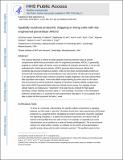| dc.contributor.author | Hung, Victoria | |
| dc.contributor.author | Udeshi, Namrata D. | |
| dc.contributor.author | Lam, Stephanie Shih-Min | |
| dc.contributor.author | Loh, Ken H. | |
| dc.contributor.author | Cox, Kurt James | |
| dc.contributor.author | Pedram, Kayvon | |
| dc.contributor.author | Carr, Steven A. | |
| dc.contributor.author | Ting, Alice Y. | |
| dc.date.accessioned | 2016-08-29T15:28:53Z | |
| dc.date.available | 2016-08-29T15:28:53Z | |
| dc.date.issued | 2016-02 | |
| dc.identifier.issn | 1754-2189 | |
| dc.identifier.issn | 1750-2799 | |
| dc.identifier.uri | http://hdl.handle.net/1721.1/104056 | |
| dc.description.abstract | This protocol describes a method to obtain spatially resolved proteomic maps of specific compartments within living mammalian cells. An engineered peroxidase, APEX2, is genetically targeted to a cellular region of interest. Upon the addition of hydrogen peroxide for 1 min to cells preloaded with a biotin-phenol substrate, APEX2 generates biotin-phenoxyl radicals that covalently tag proximal endogenous proteins. Cells are then lysed, and biotinylated proteins are enriched with streptavidin beads and identified by mass spectrometry. We describe the generation of an appropriate APEX2 fusion construct, proteomic sample preparation, and mass spectrometric data acquisition and analysis. A two-state stable isotope labeling by amino acids in cell culture (SILAC) protocol is used for proteomic mapping of membrane-enclosed cellular compartments from which APEX2-generated biotin-phenoxyl radicals cannot escape. For mapping of open cellular regions, we instead use a 'ratiometric' three-state SILAC protocol for high spatial specificity. Isotopic labeling of proteins takes 5–7 cell doublings. Generation of the biotinylated proteomic sample takes 1 d, acquiring the mass spectrometric data takes 2–5 d and analysis of the data to obtain the final proteomic list takes 1 week. | en_US |
| dc.description.sponsorship | National Science Foundation (U.S.) (NSF Graduate Research Fellowship) | en_US |
| dc.description.sponsorship | United States. Dept. of Defense (National Defense Science and Engineering Graduate Fellowship) | en_US |
| dc.description.sponsorship | National Institutes of Health (U.S.) ((NIH R01 CA186568) | en_US |
| dc.description.sponsorship | Howard Hughes Medical Institute (Collaborative Initiative Award) | en_US |
| dc.language.iso | en_US | |
| dc.publisher | Nature Publishing Group | en_US |
| dc.relation.isversionof | http://dx.doi.org/10.1038/nprot.2016.018 | en_US |
| dc.rights | Article is made available in accordance with the publisher's policy and may be subject to US copyright law. Please refer to the publisher's site for terms of use. | en_US |
| dc.source | PMC | en_US |
| dc.title | Spatially resolved proteomic mapping in living cells with the engineered peroxidase APEX2 | en_US |
| dc.type | Article | en_US |
| dc.identifier.citation | Hung, Victoria, Namrata D. Udeshi, Stephanie S. Lam, Ken H. Loh, Kurt J. Cox, Kayvon Pedram, Steven A. Carr, and Alice Y. Ting. "Spatially resolved proteomic mapping in living cells with the engineered peroxidase APEX2." Nature Protocols 11:3 (February 2016), pp.456-475. | en_US |
| dc.contributor.department | Massachusetts Institute of Technology. Department of Chemistry | en_US |
| dc.contributor.mitauthor | Hung, Victoria | en_US |
| dc.contributor.mitauthor | Lam, Stephanie Shih-Min | en_US |
| dc.contributor.mitauthor | Loh, Ken H. | en_US |
| dc.contributor.mitauthor | Cox, Kurt James | en_US |
| dc.contributor.mitauthor | Pedram, Kayvon | en_US |
| dc.contributor.mitauthor | Ting, Alice Y. | en_US |
| dc.relation.journal | Nature Protocols | en_US |
| dc.eprint.version | Author's final manuscript | en_US |
| dc.type.uri | http://purl.org/eprint/type/JournalArticle | en_US |
| eprint.status | http://purl.org/eprint/status/PeerReviewed | en_US |
| dspace.embargo.terms | N | en_US |
| dc.identifier.orcid | https://orcid.org/0000-0002-2687-3470 | |
| dc.identifier.orcid | https://orcid.org/0000-0003-4994-2392 | |
| dc.identifier.orcid | https://orcid.org/0000-0002-8277-5226 | |
| dc.identifier.orcid | https://orcid.org/0000-0003-3972-2820 | |
| dc.identifier.orcid | https://orcid.org/0000-0001-8156-1915 | |
| mit.license | PUBLISHER_POLICY | en_US |
| mit.metadata.status | Complete | |
